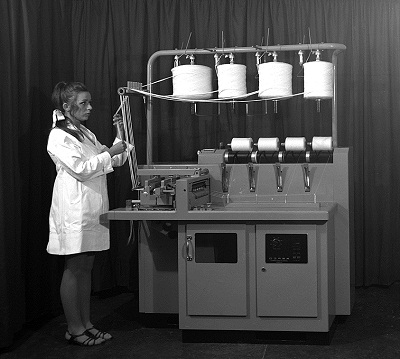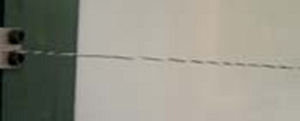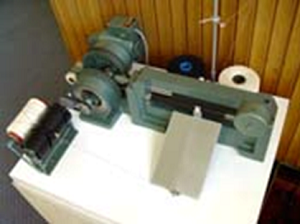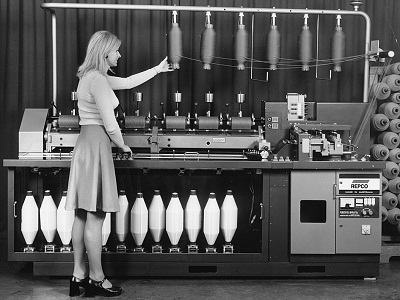Self-twist yarn
David Henshaw, who worked with the Division of Textile Industry, commercialised a novel approach to the spinning of worsted yarn which formed the basis of self-twist spinning, an entirely new concept in textile processing.
In partnership with Repco Ltd, spinning machines were commercially manufactured in Melbourne that could spin worsted yarn ten times faster than conventional spinning machines.
In 1970 the Repco Spinner won the Prince Philip Prize for industrial design.
The beginning
For physicist David Henshaw it was a moment when weeks of thought wove into one complete and perfect pattern. An instant in which he found the way around a problem which had baffled wool spinners for 200 years.
David Henshaw, from the CSIRO Division of Textile Industry at Geelong in Victoria, had spent months investigating wool-spinning – an operation unchanged since a fateful day in 1764 when Jenny, the small daughter of an impoverished English spinner James Hargreaves, knocked over his spinning wheel, and Hargreaves, seeing how the spindle continued to turn while upright, had that flash of intuition which produced the spinning jenny. His invention increased a spinner’s output eight times and changed spinning from a simple cottage craft to a complex component of the Industrial Revolution, feeding those ‘dark satanic mills’ of poet William Blake.
Wednesday 8 February 1961 was a day of sudden and unexpected rain which ended 13 days of acute fire danger and put out bushfires across the State. It was the day on which Henshaw, a sandy-bearded, laconic man with a reserved manner, sat down once again in the poky library of the old Division of Textile Industry building and surrounded himself with the books and papers he had gathered in his research. He had run into a blank wall with the realisation that mechanical improvement to Hargreaves’s invention had an absolute limit. It was impossible to turn the spindle which spun wool ‘rovings’ into yarn faster than 10 000 revolutions a minute. This produced about 15 metres of yarn a minute – and it takes 20 000 metres to make up an average two-piece suit. If a spindle went faster than this, centrifugal forces became too high and the yarn broke. This was the point at which all research had foundered.
A flash of inspiration
So David Henshaw began thinking laterally. If he could not make a better spindle he would find a way of making a different yarn. Conventional yarn was spun with a single-direction twist so he looked at alternate twist and then double-folded alternate twist. But it was not much good. The twist was unstable and easily unravelled, particularly under tension. It seemed to be yet another dead end.
And then, suddenly, he had the answer. Bundling up his papers, he hurried to the nearby office of his colleague Gordon Walls. There was a blackboard on one wall and with a few quick chalk lines he drew his extraordinary but simple discovery… take two lengths of wool rovings pinned at their heads and twist the middle of each independently, in the same direction. Now hold them togetherand then release them.
What happens? The energy stored in the twist makes them wrap around each other to form a new type of yarn with an alternating twist. And, despite the reversal of twist, its strength is still comparable with conventional yarn. Because only a very small section need be rotated to impart the twist, it can be spun at virtually limitless speed. Hargreaves’s old twist-imparting spindle and its successors could be thrown out the window.

The discovery
The discovery was to Walls an instantaneous and perfect solution. He was even more excited than Henshaw who had ploughed through those months of tedious groundwork. For years Walls had worked on cotton and rayon spinning research in England and he immediately saw tremendous implications.
But after the first terrific rush of excitement came the long, frustrating and sometimes disheartening work of inventing a machine that would make the new ‘self-twist’ yarn a reality on the factory floor.
Secrecy at this time was vital to allow maximum development before patents were taken out. The Chief of the Division of Textile Industry, Dr M. (Pip) Lipson, gave Henshaw a small room tucked away in a remote corner of the crowded red-brick building that then housed the Division of Textile Industry. They installed a workbench and then the door was locked. It stayed locked, except for Henshaw’s frequent visits to the machine workshop, for the next 15 months. Henshaw, a spare-time handyman, devised a Heath Robinson contraption of spinning tubes and intricate components machined for him by two tool-makers who had been sworn to secrecy.
It worked, but only just. They pressed on, graduating to a more sophisticated machine using rotating discs with arcs of rubber arranged to insert intermittent twist as rovings were pulled between them. This worked well enough to produce self-twist yarns in quantities which could be tested for weaving. Henshaw and Walls had the very first self-twist worsted suits made and gave them everyday wear. None of their textile-conscious colleagues picked the new fabric from conventional cloth.

Finding a partner
CSIRO then brought the manufacturing firm of Repco Ltd into the project to build three prototype machines. Repco had an outstanding reputation both in design and in manufacture of working machines for industry. The machines were produced in Melbourne by their subsidiary Repco Textile Machinery Co. Previous experience had shown CSIRO the problems of working with distant machinery manufacturers in Europe and America.
But the process was still too slow. The main problem was twisting the yarn – a sideways movement – while moving it forward onto a spindle as fast as possible. These conflicting movements seemed to restrict severely the speed at which a machine could be made to operate.
Then Walls hit on the idea of using rollers instead of discs to impart twist. He found that by reciprocating a pair of rollers (making them move backwards and forwards along their axes) he could get the twist in the wool strands, while continuous rotation of the rollers moved the strands forward.
He selected a pair of standard rubber sleeves from the machine-room stock to use as rollers and by purest chance they worked first time. (He found just how lucky he had been when later tests showed that none of the other 25 types of sleeve in stock would have worked.)
The choice of Repco now proved to be a winner. Their team, under Lionel Stern, created a machine of engineering and design standards that surpassed anything seen in the textile industry. Their first batch of six machines was delivered to CSIRO in early 1969. They were hidden in a back room at Geelong and put to work on 24-hour shifts.
Commercialisation
By now patents had been published in many of the 24 countries where CSIRO had sought protection but still no whisper reached any of the hundreds of overseas textile experts visiting the Geelong Division. The Prime Minister, Sir Robert Menzies, was given Clan Menzies tartan curtains for his study made from self-twist yarn, but not even he was told of the new process. Finally, after feeding many thousands of metres of fabric into commercial outlets, CSIRO was satisfied that self-twist was a ‘goer’ and ready for the outside world.
These first-generation machines increased the output of yarn from 20 metres a minute to 220 metres and decreased the size of the machine by 80%. Of the six machines, three were sent to Australian mills and two to Britain for trials and demonstration. The remaining one stayed at Geelong for further testing.
On 10 February 1970 more than 200 wool industry men gathered at Geelong to see the first public demonstration and, at last, self-twist was out in the open. They saw a machine spin-fling wool 12 times faster than it had ever been spun before. More than that, the machine was quieter and more pleasant to work than any other, and used less power.
But there was a last-minute crisis. A year later one of the machines sent to England developed swollen rollers only weeks before it was to go on display at the International Textile Machinery Exhibition in Paris. Typically roller failure occurred after only 150 hours of operation. The cause of its malaise was diagnosed as a special oil widely used in Europe to lubricate the wool fibres, and an urgent call for help was cabled back to Geelong. The urgency of the problem initiated an intensive investigation to determine the cause of the roller failure and if necessary to develop new rollers suitable for widely-sourced wool and synthetic rovings. Chemists in the Division led by Bert Anderson, developed a new lipid-resistant, non-swelling synthetic rubber (polyurethane elastomer) containing various friction-modifying components and the machine was given new rollers just in time for the exhibition opening. These rollers were equally successful spinning wool, wool blends and synthetic fibres.

The Repco Spinner
Industrial scale manufacture of the new rollers required relatively unsophisticated equipment and with assistance from CSIRO, Repco set up their own manufacturing plant for this purpose.
By 1976 more than 1 600 machines worth $15 million have been exported. The benefit to the wool industry was enormous. Spinning costs for self-twist wool yarn were cheaper per kilo than with conventional methods.
Ten self-twist spinners were installed at Macquarie Worsteds in Albury in 1971 and soon indicated their potential. The machines, operated in a small air-conditioned room by one girl, had an output of 1 200 conventional spindles worked by three girls. By 1976 Macquarie Worsteds had put in another 20 self-twist spinners. But they were only the second generation of machines. At the International Textile Machinery Exhibition in Milan in 1975, Repco unveiled the third generation – the SELFIL spinner.
The SELFIL spinner produces a completely new type of yarn from a mixture of wool and synthetics. The yarn, consisting of 80 per cent or more of wool, is superbly strong and long-wearing and is ideal for knitting into a wide range of garments. It consists of two thin continuous strands of nylon or other synthetic fibre twisted around a central strand of wool, spun at 16 times the speed of conventional machines. The process has opened up a whole new market for wool in the field of commercial knitting – a market which was virtually closed to wool because of costs and breakage of the yarns. The SELFIL spinner revolutionised wool knitting around the world and put wool back into strong competition with synthetics.

Honours and awards
For his research on self-twist Dave Henshaw was made a Member of the Order of the British empire (MBE) in 1970.
In 1971 the Repco Spinner won the Prince Philip Design Prize for industrial design. (Curiously, Prince Philip had been one of the first people to handle self-twist material without knowing it, when he officially opened Clunies Ross House in Melbourne in 1969, and admired the curtains. Several people were tempted to tell him the secret – but nobody did.)
Then in 1972 Henshaw and Walls shared the $10 000 Encyclopaedia Britannica Australia Award for Science with Lionel Stern of Repco Ltd.
Sources
- McKay A, 1976, Surprise and Enterprise, Fifty Years of Science for Australia, CSIRO Publishing.
- Williams VA, 1998, From Fleece to Fabric – Fifty Years of Wool Textile Research 1948-1998, CSIRO Wool Technology, Geelong, Australia.
